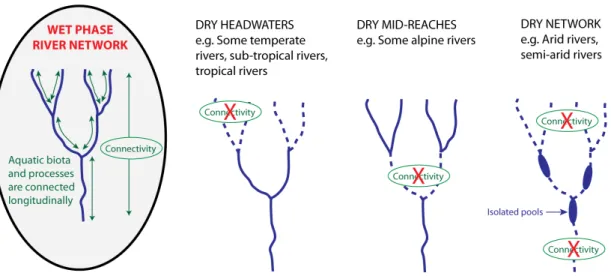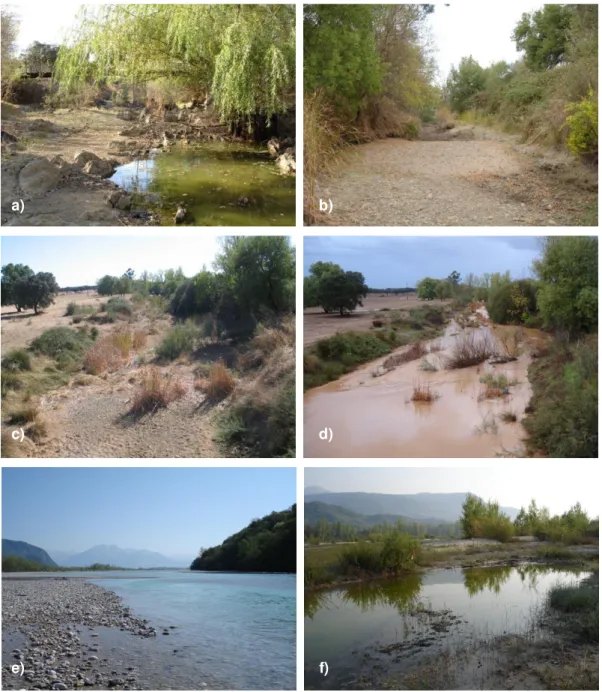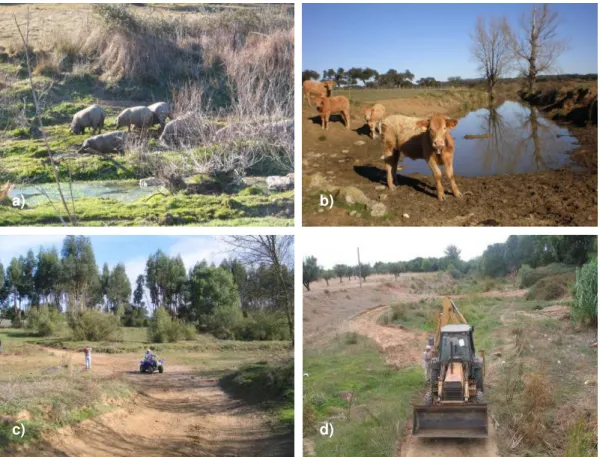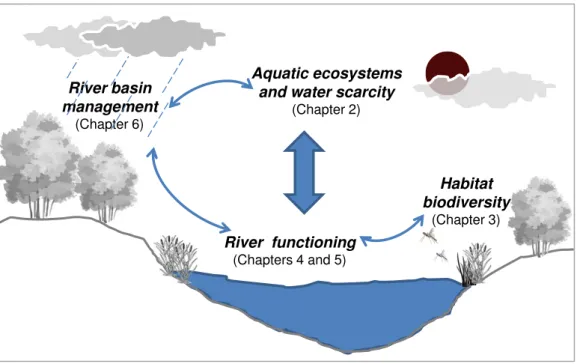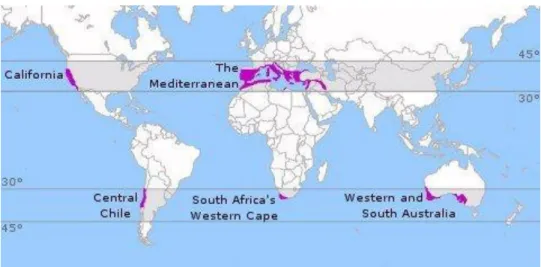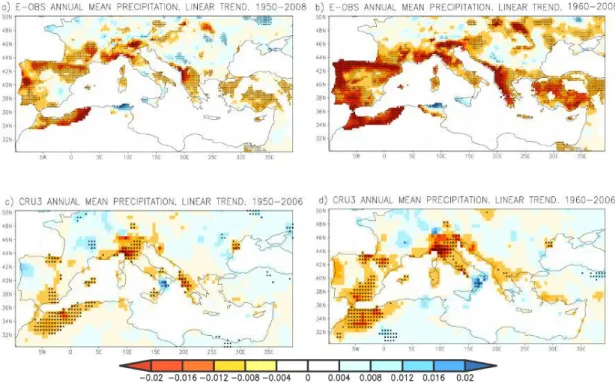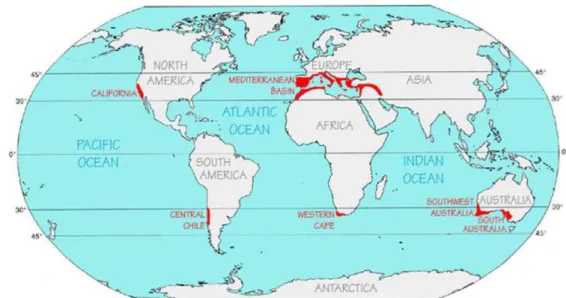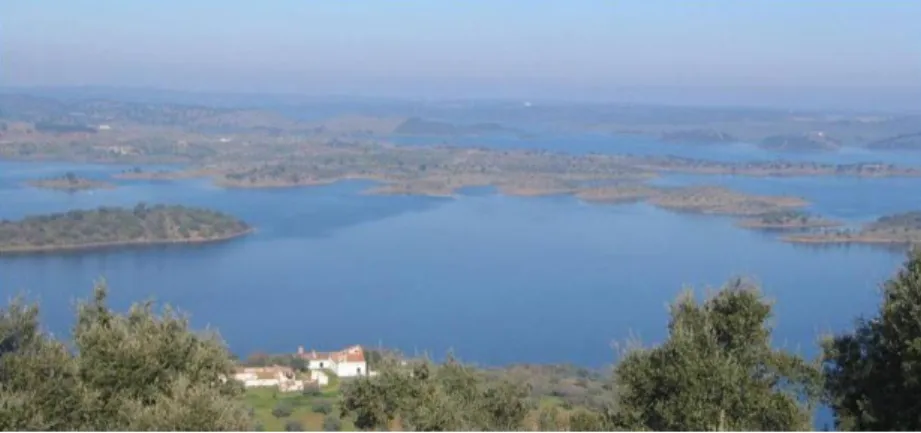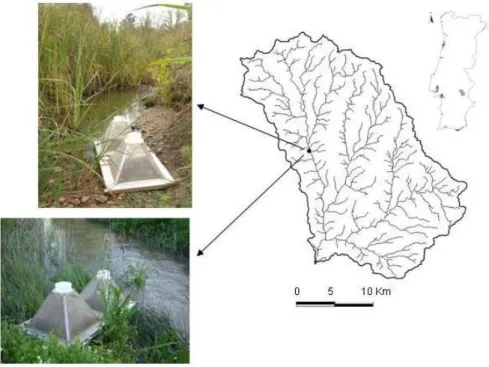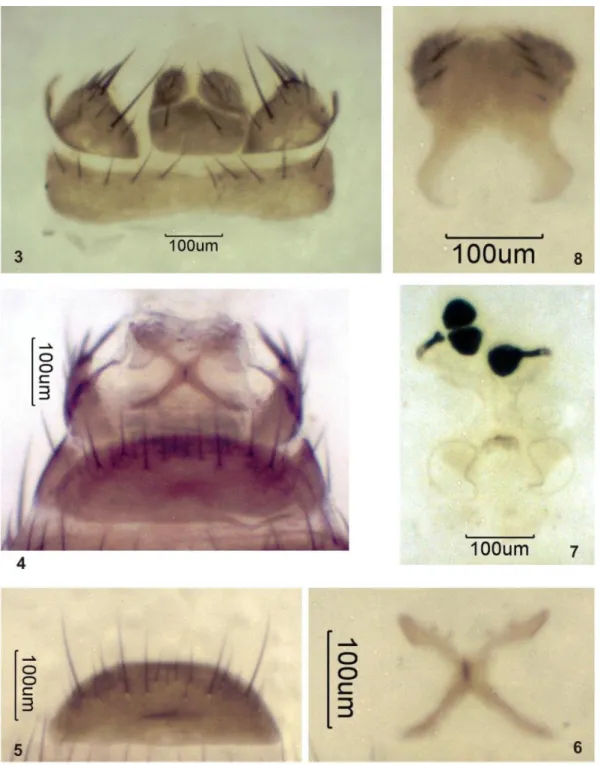ÉVORA, NOVEMBRO DE 2012
ORIENTADORES: Maria Manuela Morais Klement Tockner
Tese apresentada à Universidade de Évora
para obtenção do Grau de Doutor em Biologia
Joana Isabel Caeiro Condeço Rosado
ECOSYSTEM FUNCTIONING OF
INSTITUTO DE INVESTIGAÇÃO E FORMAÇÃO AVANÇADA
ECOSYSTEM FUNCTIONING OF
TEMPORARY RIVERS
Joana Isabel Caeiro Condeço Rosado
Tese apresentada à Universidade de Évora
para obtenção do Grau de Doutor em Biologia
ORIENTADORES: Maria Manuela Morais Klement Tockner
The research presented in this thesis was carried out in the
Laboratório da Água - Universidade de Évora, in the Swiss
Federal Institute of Aquatic Science (Eawag), Switzerland
and in the Leibniz-Institute of Freshwater Ecology and
Inland Fisheries (IGC), Germany.
This research was funded by Fundação para a Ciência e
Tecnologia, POPH (Programa Operacional Potencial Humano,
QREN), PhD fellowship SFRH/BD/18359/2004/41ZX.
All photographs by J. Rosado, except when indicated.
This thesis should be cited as:
Rosado, J. (2012). Ecosystem functioning of temporary rivers. Ph.D. Thesis, Universidade de Évora, Évora, Portugal.
Acknowledgements / Agradecimentos
This research work does not reflect the effort of a single person but rather the combination of several contributions and so, it is my will to express the recognition and sincere gratitude to all those involved in my work throughout the years. The thesis was indeed a teamwork!
First and foremost, I want to thank my two supervisors, Prof. Maria Manuela Morais and Prof. Klement Tockner for all their support and guidance, and to whom I am deeply grateful for foster my interest in aquatic ecology. I have to thank both of them for all the supporting that started in the very beginning, when the thesis was a single proposal, until the so desirable end, and all the adjoin distress. They addressed creative ideas to my working process and kept me going, even when difficult situations came into my way. To Prof. Manuela I recognize her hard work, confidence, encouragement and friendship during the last years. Despite all constrains, she provided me all the resources needed to carry out the fieldwork, as well as samples processing and laboratory analysis. I still remember with mood all the problems that we had to deal with customs authorities just to get the emergence traps, offered by Prof. Klement, from the airport, and all the chocolates raisins that she remembered bringing to make my fieldwork during weekends sweeter. To Prof. Klement thanks for kindly receiving me at EAWAG (Switzerland) and IGB (Berlin) and for his promptness in responding to my solicitations, despite being so far away. He provided me full support since the beginning, not only in practical terms (i.e., fieldwork material, literature) but also in providing me new life experiences and open my mind to different life perspectives. I am also very grateful to Klement’s wife, Barbara and their lovely daughters, for their pleasant welcome and great meals. I really enjoyed our amusing dinners and very enlightening talks. Those relaxing moments will remain in my memory!
I am very grateful to my colleagues of the Laboratório da Água and, in particular to Maria Helena, António, Helena, Ana, Anabela, Pedro, Elsa and Margarida. To all of you thank for your generous support and friendship! Despite all the difficulties, you kept supporting me in the fieldwork, laboratory analysis and during the entire thesis working process.
I am also very grateful to my colleagues from Eawag, particularly Simone Langhans, Ana Ostojić, Michael Doering and Simone Blaser for the work collaboration in Switzerland and Italy. Special thanks to Claudio Cruciat and Ombretta Mingolo for the basic life support in River Tagliamento and the amazing pizzas!
I cannot forget all the practical help given by my good friend and colleague Maria Helena for reading this thesis and for her priceless corrections and advices especially during the last two years; António for the figures preparation and all the graphic design of the thesis; João Matos for the help in the fieldwork, Maria da Luz, Sérgio and Joel for all the unreserved friendship and for keeping me believing! Special thanks to my very best friend, cousin and colleague
Helena, for the extra journey to the River Tagliamento, utter friendship and for taking care of my furry roommate during my absences. It would have been impossible without all their help and faith in me!
I am also very thankful to my mother for all the encouragement, patience, and unconditional love during all these years.
“To all my family and friends, for all the time I didn’t spend with them…” (M.H. Novais)
I cannot imagine going through this thesis without your constant support, love and understanding. Obrigada a todos!
I dedicate this thesis to my wonderful little stars, aunt Quina and grandmother Jacinta who passed away this year.
Funcionamento de ecossistemas de rios temporários
Resumo
O presente estudo abrange questões relevantes sobre o funcionamento de rios temporários. São abordados diferentes tópicos tais como a problemática da escassez de água particularmente na bacia Mediterrânica, a biodiversidade aquática e ripícola, a dinâmica de nutrientes e fatores fundamentais para a gestão e conservação de rios temporários Mediterrânicos. O principal objetivo é estudar alguns dos processos que ocorrem ao nível da bacia de drenagem e galeria ripícola associada, fazendo sempre a ligação dos resultados obtidos com a importância de uma correta gestão da bacia hidrográfica. Os resultados obtidos demonstraram uma necessidade urgente de implementação de estratégias de gestão adequadas ao nível das bacias hidrográficas de forma a reduzir a vulnerabilidade dos rios temporários. A tese pretende acima de tudo adicionar informação sobre rios temporários dada a sua importante representatividade a nível mundial.
Palavras-chave: rios temporários, disponibilidade de água, biodiversidade de água doce,
dinâmica de nutrientes, gestão e conservação de bacias hidrográficas
Ecosystem functioning of temporary rivers
Abstract
This research intended to address some relevant issues concerning the functioning of temporary rivers. It will be approached different topics such as water scarcity particularly in the Mediterranean basin, aquatic and riparian biodiversity, nutrients dynamics and key factors in the management and conservation of temporary Mediterranean streams. The main aim is to study some of the processes that occur within the river basin and subjacent riparian gallery, always linking the obtained data with the importance of a correct river basin management. The results showed an urgent need to implement suitable management strategies at river basin level to reduce the vulnerability of temporary rivers. This thesis intends most of all to increase the knowledge on temporary rivers given their important worldwide representativity.
Key words: temporary rivers, water availability, freshwater biodiversity, nutrient dynamics,
management and conservation of river basins
Contents
Acknowledgements / Agradecimentos... i Resumo... iii Abstract ... iv List of Figures ... vi List of Tables ... x 1 General introduction... 12 Main problems concerning water scarcity in the mediterranean regions ... 15
2.1 Climate change and water scarcity: from a global scale to particular aspects in Mediterranean region (Portugal) ... 17
2.2 Strategies for the management of water scarcity in semiarid and mediterranean climate regions (Estratégias de gestão da água em situação de escassez: regiões semiáridas e mediterrâneas) ... 27
3 The importance of temporary streams biodiversity ... 47
3.1 Some dipterans from Portugal captured by emergency traps (Insecta, Diptera) (Algunos dípteros de Portugal capturados mediante trampas de emergencia (Insecta, Diptera)) ... 49
4 Effects of first flood event in dry riverbed ... 61
4.1 Mass dispersal of terrestrial organisms during first flush events in a temporary stream ... 63
5 The seasonal inundation dynamics on ecosystem functioning ... 77
5.1 Release of nutrients and organic matter from river floodplain habitats: simulating seasonal inundation dynamics ... 79
5.2 The effect of different nutrient sources and first flood event on system functioning in a Mediterranean temporary stream (SE Portugal) ... 100
6 Temporary rivers management ... 119
6.1 Key factors in the management and conservation of temporary Mediterranean streams: a case study of the Pardiela river, southern Portugal ... 121
List of Figures
Chapter 1. General introduction
Figure 1. Examples of drying in temporary river basins, and how it interferes in river network
connectivity (Steward et al., 2012). ... 4
Figure 2. Different phases of Mediterranean temporary rivers: Pardiela Stream (SE Portugal)
detail of: summer pool (a), dry riverbed (b), riverbed before flood event (c) and during flood event (d); and Tagliamento River (NE Italy) detail of main channel (e) and pool in vegetated islands (f). ... 5
Figure 3. The cultural significance of dry riverbeds: cattle pasture (a, b), recreation place (c)
and sediment extraction/vehicles crossing (d). Photos b) and c) by M. Morais. ... 7
Figure 4. Illustration of the link between the themes discussed in each chapter of the thesis.
Chapter 2 is an overall approach to the theme climate change and water scarcity. Chapters 4, 5 and 6 include different themes concerning river functioning and management, and chapter 3 is a contribution to the knowledge of insect biodiversity. ... 9
Chapter 2. Main problems concerning water scarcity in the mediterranean regions 2.1. Climate change and water scarcity: from a global scale to particular aspects in Mediterranean region (Portugal)
Figure 1. Global surface air temperature variation between 1951 and 1980 (adapted from
GISS, 2009). ... 19
Figure 2. Map of the distribution of mediterranean climate over the world. ... 20
Figure 3. Mean annual precipitation tendencies (mm/day/year) obtained from E-OBS and
CRU TS 3.0. databases, to time series 1950-2006 (left, 2008 to E-OBS) and 1960-2006 (right, 2008 to E-OBS). Black dots shows significant tendencies with 95% confidence level (p<0.05), Mann-Kendall test. White regions show areas without enough available data (adapted from Bladé & Díez, 2010). ... 22
2.2. Strategies for the management of water scarcity in semiarid and mediterranean climate regions (Estratégias de gestão da água em situação de escassez: regiões semiáridas e mediterrâneas)
Figure 1. Distribuição das regiões de clima mediterrâneo (adaptado de Di Castri, 1981). . 32
Figura 2. Cisterna rural em Afogados da Ingazeira (Bacia do Rio Pajeú – Nordeste
brasileiro)1. ... 36
Figura 3. Alqueva, o maior reservatório de Portugal e da Europa, com 90 km de extensão
Figura 4. Barragem subterrânea (Bacia do Rio Pajeú –Nordeste brasileiro)1. ... 38 Figura 5. Construção de canais de transferência de água do Rio São Francisco para a região
do nordeste brasileiro1. ... 40
Figura 6. Cisterna da vila de Monsaraz, séculos XIV-XV (sul de Portugal) 1. ... 42
Chapter 3 The importance of temporary streams biodiversity
Figura 1. Localización del arroyo Pardiela y ubicación de dos parejas de trampas. ... 51 Figura 2. Detalle de la colocación de una pareja de trampas de emergencia mostrando su
situación en la orilla del arroyo (adaptado de Paetzold & Tockner, 2005). ... 51
Figura 3-8. Genitalia de la hembra de Rachispoda iberica (Roháček): 3) terguitos 7, 8, 10 y
cercos en visión dorsal (aplanados con un cubreobjetos); 4) esternitos 7,8 y terguito 8 en visión ventral; 5) esternito 7 en visión ventral; 6) esternito 8 en visión ventral; 7) esclerito interno, círculos membranoso y espermatecas; 8) esternito 10 en visión ventral. ... 57
Chapter 4. Effects of first flood event in dry riverbed
Figure 1. Pardiela stream (SE Portugal): dry bed conditions in summer (a), first flood event
(b), and coarse particulate organic matter deposits after flood recession (c, d). ... 65
Figure 2. Hydrograph of the Pardiela stream (2004-2006). Arrows indicate the first flush
event. W winter; Sp spring; S summer; A autumn. Data: SNIRH (2007). ... 66
Figure 3. Mean arthropod biomass g dry mass CPOM (upper panel) and mean density Ind.
g dry mass CPOM (lower panel) (Mean±SD; n=24 for “Dry riverbed”; n=30 each for “Day 0, Day 5 and Day 10”). ... 68
Figure 4. Relative composition (%) of the arthropod assemblages (pooled data for each
date and year, 2005-2006; total n=114). ... 69
Figure 5. Organic matter deposits (g DM OM) and arthropods density (Ind./g DM CPOM)
immediately after flow recession (Day 0, 2005-2006; n=30). ... 70
Chapter 5. The seasonal inundation dynamics on ecosystem functioning
5.1. Release of nutrients and organic matter from river floodplain habitats: simulating seasonal inundation dynamics
Figure 1. Map of Tagliamento catchment (NE Italy, Europe), and the location of the
island-braided study reach (arrow) (modified after Ward et al.,1999). ... 82
Figure 2. Grayscale image of the island-braided study site of the Tagliamento River
showing the complex mosaic of aquatic and terrestrial habitat types (May 2007; photo by A. Ostojić). ... 83
Figure 3. Relative leaching rates (average ± SE; mg g-1; n = 4 per treatment) of DOC,
Figure 4. Relative leaching rates (average ± SD, n = 3 per habitat) of DOC, TDN and
TDP from seven habitat types at 12°C after 36 h of inundation……….90
5.2. The effect of different nutrient sources and first flood event on system functioning in a Mediterranean temporary stream (SE Portugal)
Figure 1. Map showing the geographic localization of Pardiela catchment (38° 38’ N, 07°
42’W) and sampling reach (marked with black dot; river km 10). Identification of the main pollution sources by category: small rural industrial, agricultural and urban sources (INAG, 2012). ... 103
Figure 2. Hydrograph for the two hydrological years (2003/2004 and 2004/2005; SNIRH,
2007). Arrows show the first flood events. ... 103
Figure 3. Photos from Pardiela stream: magnitude of first flood events in Pardiela
catchment (a); macrophytes maximum standing crop at the end of spring (b); dry riverbed at the end of summer; detail of vertical traps and leaf litter deposits (c); and the presence of biofilm in cobbles and sediment (d). ... 104
Figure 4. Monthly variation of (a) total nitrogen (TN), (b) total phosphorus (TP) and (c) total
suspended solids (TSS) loads, during the two hydrological years 2003-2005. ... 107
Figure 5. Mean monthly variation of periphytic autotrophic biomass (chlorophyll-a, mg/m2)
in Pardiela stream. Mean monthly temperature variation values from SNIRH (2007). Arrows show the first flood event. ... 108
Figure 6. Mean biomass (gDW/m2) of the most dominant macrophytes in riverbed (Typha
angustifolia, Scirpoides holoschoenus and Cyperus longus subsp. badius and small hydrophytes) at dry riverbed (end of the dry period) and after the first flood event. ... 110
Figure 7. Monthly variation of leaf litter in Pardiela stream (gDW/m2; mean+SE)... 111
Figure 8. Conceptual summary of different nutrient and organic carbon sources in
Pardiela stream and their major outcomes to the aquatic system. ... 113
Chapter 6. Temporary rivers management
Figure 1. Map of Portugal, showing the location of the River Pardiela catchment (38° 38’ N,
07° 42’W), the 1 km× 1 km study site (black dot) and Vigia reservoir (a). Aerial photographs of the study site taken in 1958 (left) and 2005 (right) (b). ... 124
Figure 2. Annual variability of mean air temperature in the River Pardiela catchment
during 1941–2006. The dashed line represents the average air temperature during the period 1961–1990 (data from the Évora weather station) (a). Progressive (blue) and retrograde (red) series of Mann-Kendall statistic test (b). The dashed lines represent the significance boundaries (t = 1.96; = 0.05). ... 126
Figure 3. Annual variability of mean precipitation in the River Pardiela catchment during
1932–2007. The dashed line represents the average air temperature during the period 1961–1990 (data from the Azaruja and Santa Susana meteorological stations) (a). Progressive (blue) and retrograde (red) series of Mann-Kendall statistic test (b). The dashed lines represent the significance boundaries (t = 1.96; = 0.05). ... 127
Figure 4. Hydrograph outputs for the two hydrological years (October 2007–October
2009) generated from the SWAT modelling. The lines represent different reaches of the River Pardiela: black line – headwater reach; dark grey line – study site (middle reach); light grey line – downstream reach... 128
Figure 5. Total run-off for the two hydrological years (October 2007–October 2009)
generated from SWAT modelling. The main stem accounts for the greater part of total runoff (black and dark grey areas). Tributaries only add part of the total runoff, and headwater reaches have the smallest contribution to the amount of total runoff (light grey areas) . ... 128
Figure 6. Percentage of days with no discharge (October 2007–October 2009) generated
from SWAT modelling. Headwater areas have more than 89% of days without flow (light grey areas). The main-stem river has the smallest percentage of days without flow (from 56 to 84%), especially in the lowermost reaches (56%). ... 129
List of Tables
Chapter 1. General introduction
Table 1. General overview of the major chapters with research questions and main outputs….9
Chapter 2. Main problems concerning water scarcity in the mediterranean regions
Table 1. Numbers of species from Mediterranean basin countries assigned to each IUCN Red
List category, by taxonomic group. Assessments carried out between 2004 and 2008 by IUCN and partners. Data Deficient means that there is not enough information to assign the species to a category; does not imply that the species is not threatened (adapted from Cuttelod et al., 2008)……… ... ….21
Table 2. Droughts in Portugal in the last 70 years (adapted from Afonso, 2007)………… .... .23
Chapter 4. Effects of first flood event in dry riverbed
Table 1. Pairwise comparisons (density and biomass) between dates (i.e., days) and years.
Arthropods density was not significantly different between years. Significant differences marked in bold. ... 70
Chapter 5. The seasonal inundation dynamics on ecosystem functioning
5.1. Release of nutrients and organic matter from river floodplain habitats: simulating seasonal inundation dynamics
Table 1.Characterization of the sediments from aquatic and terrestrial habitats, and of poplar
leaves (mean ± SD; n = 3). Grain size distribution (% of the sum of all size fractions), water content (% of dry sediment), carbon and nutrient content (mg/g dry mass sediment) in size fraction <2.0 mm. ... 87
Table 2. Repeated measures ANOVA tests for differences in leaching rates of seven
parameters between aquatic and terrestrial habitats, and minimum and maximum total and relative leaching rates (single observation value) along with protocols where they were measured. Mean total and relative leaching rates (average ± SD, n = 3 per habitat) pooled from seven habitats at 12°C after 36 h of inundation……….………..88
Table 3. Repeated measures ANOVA tests for the effects of temperature and duration of
inundation on relative leaching rates in aquatic and terrestrial habitats. *** p<0.001; **p<0.01; * p<0.05; n.s.= not significant. ... 91
Table 4. Results of the multivariate test of significance (Wilks test) for the effects of
Table 5. Ecosystem properties and processes of various aquatic and terrestrial habitat
types of the Tagliamento River. Mean values are given for grain size distribution, organic matter content, sediment respiration, leaf-litter decomposition (coarse mesh size), and leaching. Detailed information about methods and results are given in Langhans et al. (2008), Döring et al. (2011), Tockner et al. (2010) and this study. ... 95
5.2. The effect of different nutrient sources and first flood events on system functioning in a temporary stream (SE Portugal)
Table 1. Nutrient content of total carbon, nitrogen and phosphorus at the end of the dry period
(mean ± SD). ... 112
Chapter 6. Temporary rivers management
Table 1. Generic proposals for the management and conservation in temporary
Mediterranean stream corridors. ... 131
Chapter 7. Final overview
Chapter 1
1.1
The pivotal role of freshwater ecosystems
Freshwater ecosystems represent around 3% of Earth’s water, of which only a small fraction is in the form of lakes and ponds, rivers and streams, reservoirs, wetlands, and groundwater. This small portion of available freshwater is shared by the Earth’s 7 billion people (CIA, 2012), highly dependent on freshwater for agriculture, industry, recreation, tourism, and municipal use. The rapid population growth over the past centuries has raised concerns related to the increasing demand for natural resources, which is sometimes faster than their rate of regeneration, and the subsequent negative impact in the environment and humans. Most freshwater ecosystems are threatened mainly due to habitat degradation, overexploitation, pollution, species invasion and global warming. Considering the actual trends, equity in water use for agriculture, industry and human consumption represents a major challenge for the 21st century (Tundisi, 2003;
UN-Water, 2006). Currently, the water scarcity constitutes a key hazard to biosphere and humankind (Tisdell, 1991).
Climatic change will have significant impacts on the spatial distribution and availability of the hydrological resources, on water quality, and on the risk of occurrence of droughts and floods (UNEP, 2010). Human-caused perturbations that increase water scarcity will promote the physical uniformity of aquatic ecosystems and lead to a decrease in the biological diversity. The increasing human pressure on water resources together with the effects of climate change, will probably affect the hydrological, the geomorphological, and the ecological status of rivers worldwide (Sabater & Tockner, 2010). Hence, the hydrological systems have been the focus of an increasing consciousness, particularly in respect to the definition of water management strategies and political decisions. Currently, in Europe, different countries are implementing the Water Framework Directive (WFD, Directive 2000/60/EC; Council of the European Communities, 2000), which makes an ecosystem approach as a support of life, assessing the status of running waters, using both physical-chemical and biological indicators (i.e., benthic invertebrates, macrophytes, phytobenthos and fish fauna). However, the management of aquatic resources and the availability of water are complex issues and of huge strategic importance for sustainable development.
1.2 The mediterranean climate rivers
1Mediterranean ecosystems are amongst the most intensely utilized ecosystems by man, and for the longest periods of time (Williams, 2006). The anthropogenic perturbations, together with the strong ecological constraints, make mediterranean-type ecosystems especially reactive to
management practices as well as to environmental alterations. One of the most characteristic features of mediterranean regions is the occurrence of temporary rivers. The temporary designation includes intermittent streams, which have flow during a certain time but it ceases occasionally/seasonally, ephemeral streams, which have flow only during and immediately after periods of rainfall or snowmelt, and episodic streams, which have flow only during very short periods of heavy rainfall).
While permanent rivers may be found in regions with a relative high and predictable rainfall, temporary rivers are located in regions with low and irregular rainfall and without strong connections to major aquifers, being mainly dependent on rainfall (e.g. Larned et al., 2010; Vidal-Abarca, 1990). Temporary streams have been described as more representative worldwide than considerably researched systems with permanent flow (Williams, 1988; Tooth, 2000). The estimation of the total length and discharge of temporary rivers is very rough: they represent about half of the total river length in Australia (Williams, 1983) and South Africa (Uys & O'Keeffe, 1997); at least 3 200 000 km of temporary rivers (60% of total river length) in the United States (Nadeau & Rains, 2007); at least 43% of Greece is drained by temporary rivers (Tzoraki & Nikolaidis, 2007); almost 50% of the 2700 km-long Tagliamento River network (NE Italy) (Doering et al., 2007) and nearly all running waters in Arctic and Antarctic regions (Vicent & Howard-Williams, 1986). In Portugal, the preliminary studies indicate that they can represent about half of the total river length (Morais et al., in preparation).
River flow alterations affect humans, especially in relation to water supply, hydropower generation, and flooding, but also affect ecosystems and its habitat suitability for freshwater-dependent biota (Poff & Zimmerman, 2010). One important consequence of flow regime alteration is the impact on aquatic and terrestrial biota living in the river (Bond et al., 2010), on riparian vegetation (Stromberg et al., 2005), and it can trigger a sequence of cascading effects that eventually affects the community structure and ecosystem functioning (Sabater & Tockner, 2010). The estimation of changes in rivers seasonality, interannual variability, low and high flows, floods and droughts is required to understand the impact of climate change on humans and freshwater ecosystems (Döll & Schmied, 2012). Hence, the knowledge concerning changing flow regimes is an overriding issue for assessing climate change risks linked to freshwaters ecosystems. Since temporary streams can occupy a huge part of river network in many catchments throughout the world, their true extent is most probably underestimated Larned et al., 2010). Thereby, any changes in the duration and extent of drying can generate a flow regime alteration, riparian degradation and lead to the loss of refugia habitats and biodiversity. Indeed, climate change is projected to exacerbate the extent of river intermittency in mediterranean streams (Milly et al., 2005; IPCC, 2007). Clearly, every changes in flow regimes will have a direct impact on the structure and function of aquatic ecosystems (Sabater & Tockner, 2010), on aquatic communities and processes (e.g. Boulton, 2003; Lake, 2003), and can affect the density, composition, and dominance patterns of riparian vegetation (Poff & Zimmerman, 2010). Overall, a change in the flow regime alters the relative proportion of input, storage, transfer, and transformation of organic matter and nutrients, and therefore affects the
capacity of river networks to produce and transform material and energy (Sabater & Tockner, 2010). The effective conservation of the biodiversity in the mediterranean will require an increased focus on global anthropogenic interferences and their synergistic effects, which even if known, are poorly understood (Underwood et al., 2009).
1.3 Temporary rivers undergo characteristic environmental and biotic cycles
Temporary rivers and streams naturally cease to flow and dry during a certain period. They expand and contract over time in response either to the seasonal flow regime (Stanley et al., 1997; Gasith & Resh, 1999; Doering et al., 2007), either driven by rainfall runoff and water table fluctuations, or by ice- and snowmelt runoff (Stanley & Grimm, 1997; Ward & Tockner, 2001). During maximum contraction, the entire riverbed may become dry. This leads to a temporary loss of aquatic habitats (Lake, 2003). Dry riverbeds are not confined to the headwaters reaches. They can be found in mid-reaches and lowlands, whenever there is a loss of connectivity in river networks (Fig. 1). Many arid and semiarid rivers can be dry over most of their length, and for extended times, apart from the potential presence of perennial, isolated pools (Hamilton et al., 2005).
Figure 1. Examples of drying in temporary river basins, and how it interferes in river network connectivity (Steward et al., 2012).
Following flow cessation, the remaining isolated pools undergo several stages until they eventually dry completely. During that period, pools develop specific physical, chemical, and biological characteristics and properties (Smith & Pearson, 1987). Although the drying process may be gradual, the cessation of flow may cause an abrupt loss of habitats, a major alteration of physicochemical conditions in pools, and the fragmentation of the entire river network (Fig. 2a,
b, c). Therefore, ecological responses to drying can either be gradual or abrupt (Boulton, 2003; Lake, 2003).
Figure 2. Different phases of Mediterranean temporary rivers: Pardiela Stream (SE Portugal) detail of: summer pool (a), dry riverbed (b), riverbed before flood event (c) and during flood event (d); and Tagliamento River (NE Italy) detail of main channel (e) and pool in vegetated islands (f).
The large variability of climate conditions that are typical for Mediterranean streams may influence the hydrological regime and the input and retention of organic matter (Sabater et al., 2001). Thus, climate variability may result in significant accumulations of organic matter during low flow and to a huge downstream transport during first flood events (Acuña et al., 2004). Indeed, water flow is the most critical force that controls organic matter accumulation and
a) b)
c) d)
transport in temporary streams (Acuña et al., 2004, 2005). The expansion and contraction cycles also lead to “booms” and “bust” periods for both aquatic and terrestrial ecosystem processes and biotic communities such as water birds, fish, and plants (Jenkins & Boulton, 2003). Larned et al. (2010) suggested a simple model whereas the aquatic biodiversity of temporary rivers increases with water level, with a subsequent increasing of the proportion of available aquatic habitats and resulting increase in diversity. In their model, the response of terrestrial biodiversity to changes in water level is approximately the opposite of the aquatic response, indicating the linking between aquatic ecosystems, their adjacent terrestrial environments, and the underlying relation of habitat availability and biodiversity maintenance (Larned et al., 2010).
1.4 The importance of dry riverbeds
The dry beds of temporary rivers are an essential part of river landscapes. They are important as seed and egg banks for aquatic biota, as focus of an intense biological diversity of aquatic, amphibious and terrestrial biota, as dispersal corridors, as temporal ecotones between the aquatic and the terrestrial phase (Sabater & Tockner, 2010) and as sites for the accumulation and processing of organic matter and nutrients (e.g. Steward et al., 2012). Nevertheless, dry riverbeds have been largely overlooked in the past years (Larned et al., 2010), and described as ‘biologically inactive, dry channels’ (Stanley et al., 1997). Frequently they are used for cattle pasture, gravel and sediment extraction, or as recreation places, with large negative consequences in river functioning (Fig.3; Gómez et al., 2005). Nevertheless, recent research contradicts this initial assumption and emphasizes the important societal and ecological values of dry riverbeds (Steward et al., 2012).
During the dry period, the invertebrate assemblages become‘terrestrial’, with a shift from an aquatic-dominated assemblage to a terrestrial-dominated (Steward et al., 2012). The drying causes the death of many aquatic organisms such as invertebrates and fish (Matthews & Marsh-Matthews, 2003), particularly of those which do not have desiccation-resistant stages or the ability to move to water refugia (Pringle, 1997; Steward et al., 2012). Therefore, the duration of the dry period is a vital factor for aquatic biota. Larned et al. (2007) observed that with the increasing duration of the dry period the invertebrate richness decreased linearly while the density decreased exponentially. Overall, it is imperative that dry riverbeds are recognized and fully integrated into river management and legislation, which requires suitable monitoring programs.
Figure 3. The cultural significance of dry riverbeds: cattle pasture (a, b), recreation place (c) and sediment extraction/vehicles crossing (d). Photos b) and c) by M. Morais.
1.5 General purpose of the present research
The present research intends to address relevant issues concerning the functioning of temporary rivers ecosystems. It includes key topics such as water scarcity, biodiversity, and ecosystem functioning. The main aim is to study relevant processes within the riverbed and along the riparian corridor, linking the science with an improvement of river basin management. Particular emphasis is given to temporary ecosystems, including their hydrology and ecology as well as current river basin management approaches. Temporary streams are very sensitive to anthropogenic and natural pressures that may modify their hydrology and ecology. Therefore, improvement knowledge is required.
1.6 Thesis framework
This thesis is structured in seven chapters (Fig. 4). Most chapters are based on the analysis of field data collection in Pardiela stream (Guadiana River catchment; SE Portugal). A research reported in chapter 5 includes data from the River Tagliamento (NE Italy). The thesis includes information of three published papers (chapters 2 and 3) and a book chapter (chapter 6). The other articles have been submitted or are accepted for publication in a peer reviewed journal
a) b)
(chapters 4 and 5). The structure and original content were maintained in the essential. Some of the rules concerning the formatting standard of each publication were revised in this thesis.
Chapter 2 addresses the topic of water scarcity. It is based on two review articles already
published: 1) an article regarding the particular aspects of climate change and water scarcity in the mediterranean regions, and 2) an article concerning the strategies for coping with water scarcity in mediterranean regions, comparing with the actual situation in semiarid regions.
Chapter 3 constitutes an important contribution to the limited knowledge of dipterans in
Portugal. It allowed the discovery of a new species to science (Homoneura alata sp.), the description and illustration for the first time of Rachispoda ibérica Roháček female, and the recording of several other new species for Portugal, the Iberian Peninsula and Europe. In the context of a growing awareness of the importance of biodiversity in freshwaters ecosystems, it is expected that this work will help to fill the existent gap in the knowledge of Diptera taxonomy.
Chapter 4 includes a submitted article on floating organic material as an important mass
dispersal vector for terrestrial arthropods along the river course. The most important characteristics of temporary streams are the alternation between the dry and wet periods. After the dry period, the first flush floods have a major role in the transport of organic matter and biota downstream and may constitute critical habitats, refugia, and food resources for arthropods assemblage inhabiting the dry riverbed.
Chapter 5 consists of: 1) an article accepted for publication, with the results obtained from
sediment sampling and experimental inundation simulations (Tagliamento River, Italy), and 2) an article submitted for publication with data from different type of inputs (allochthonous and autochthonous) to stream channel (Pardiela Stream, Portugal). This chapter confirms the significant role that riparian areas play as potential key energy sources to the aquatic system and downstream areas.
Chapter 6 presents the results of the effects of climate change in a temporary river catchment
from southern Portugal. One of the major problems associated with the dry period in temporary catchments is the decrease in water quality, which increases the vulnerability of rivers, both in terms of water quality and ecosystem biodiversity. An important implication of climate change is that it substantially can affect the efforts for a truly sustainable approach of river management in these regions, which are particularly sensitive to anthropogenic pressures.
Chapter 7 presents a summarized overview of the main results of this research and some
Figure 4. Illustration of the link between the themes discussed in each chapter of the thesis. Chapter 2 is an overall approach to the theme climate change and water scarcity. Chapters 4, 5 and 6 include different themes concerning river functioning and management, and chapter 3 is a contribution to the knowledge of insect biodiversity.
A number of specific research questions were addressed to each chapter, which can be summarized in the following table:
Table 1. General overview of the major chapters with research questions and main outputs.
General theme Research questions | Main outputs
C
ha
pt
er
2
Main problems concerning the water scarcity in the
mediterranean regions
How will climate change and the overexploitation of natural resources affect water availability and biodiversity in mediterranean regions? Which strategies are already being applied in order to attenuate the effects of water scarcity? Which other measures can also be adopted?
Rosado, J. & Morais, M. (2010) Climate change and water scarcity: from a global scale to particular aspects in mediterranean region
(Portugal). In: Sens, M.L. & Mondardo, R.I. (eds.).Experiences from
Brazil, Portugal and Germany. pp. 15-27. Science and Technology for Environmental Studies, Federal University of Santa Catarina, Florianópolis.
Rosado, J. & Morais, M. (2010) Strategies for the management of water scarcity in semi-arid and mediterranean climate regions. Sustentabilidade em Debate, 1, 31-46. Habitat biodiversity (Chapter 3) River basin management (Chapter 6) River functioning (Chapters 4 and 5) Aquatic ecosystems and water scarcity
General theme Research questions | Main outputs C ha pt er 3
The importance of temporary streams biodiversity
Considering that dipterans are the most common insects emerging at the beginning of the dry period, and their importance from the environment and human perspective, how limited is the actual knowledge of dipterans in temporary streams biodiversity?
Carles-Tolrá, M. & Rosado, J. (2009) Some dipterans from Portugal captured by emergency traps (Insecta, Diptera). Boletín Sociedad Entomológica Aragonesa, 44, 343-348. C ha pt er 4
Effects of first flood event in dry riverbed
How important are coarse particulate organic matter accumulations (CPOM) in dry riverbed and flood drift deposits as habitat for terrestrial arthropod assemblages?
How does the arthropod composition change in drift deposits? Rosado, J., Morais, M. & Tockner, K. (submitted to River Research
and Applications) Mass dispersal of terrestrial organisms during first flood events in a temporary stream.
C
ha
pt
er
5
The seasonal inundation dynamics and ecosystem
functioning
What are the main potential sources of nutrients in temporary streams? How do first flood events interfere in their annual variation? How does the inundation dynamics and temperature influence the release of nutrients and organic matter from sediments in floodplains? What is the effect of first flood events in dried leaf litter?
What is the role of riparian areas along temporary streams?
Ostojić, A., Rosado, J., Miliša, M., Morais, M. & Tockner, K. (2013) Release of nutrients and organic matter from river floodplain habitats:
simulating seasonal inundation dynamics. Wetlands, 33 (5),847-859.
Rosado, J., Morais, M., Guilherme, P., Lillebø, A. & Tockner, K. (submitted to River Research and Applications) The effect of different nutrient sources and first flood event on system functioning in a Mediterranean temporary stream (SE Portugal).
C ha pt er 6 Temporary rivers management
Is there already evidence of an increasing variation in long-term patterns of air temperature and precipitation in southern Portugal that could be due to climate change?
What is the best modelling approach to track and predict the presence of dry riverbed reaches in temporary river basins?
Which would be the best suitable strategies for the assessment and management of temporary river basins?
Rosado, J., Morais, M., Serafim, A., Pedro, A., Silva, H., Potes, M., Brito, D., Salgado, R., Neves, R., Lillebø, A., Chambel, A., Pires, V., Pinto Gomes, C. & Pinto, P. (2012) Key factors in the management
General theme Research questions | Main outputs
and conservation of temporary mediterranean streams: a case study of the Pardiela river, southern Portugal. In: Boon, M.P.J. & Raven, P.J. (eds.) River Conservation and Management. pp. 273-283. Wiley-Blackwell, Oxford.
1.7 References
Acuña, V., Giorgi, A., Muñoz, I., Uehlinger, U., & Sabater, S. (2004) Flow extremes and benthic organic matter shape the metabolism of a headwater Mediterranean stream. Freshwater Biology, 49, 960–971. Acuña, V., Muñoz, I., Giorgi, A., Omella, M., Sabater, F. & Sabater, S. (2005) Drought and postdrought
recovery cycles in an intermittent Mediterranean stream: structural and functional aspects. Journal of
the North American Benthological Society, 24, 919–933.
Bond, N., McMaster D., Reich P., Thomson J.R. & Lake P.S. (2010) Modelling the impacts of flow regulation on fish distributions in naturally intermittent lowland streams: an approach for predicting restoration responses. Freshwater Biology, 55, 1997–2010.
Boulton, A.J. (2003). Parallels and contrasts in the effects of drought on stream macroinvertebrate assemblages. Freshwater Biology, 48, 1173–1185.
CIA. (2012). Central Intelligence Agency - The world fact book. https://www.cia.gov/library/publications/the-world-factbook/, Accessed September 2012.
Döll, P. & Schmied, H.M. (2012). How is the impact of climate change on river flow regimes related to the impact on mean annual runoff? A global-scale analysis. Environmental Research Letters, 7, 1–11. Doering, M., Uehlinger, U., Rotach, A., Schläpfer, D.R. & Tockner, K. (2007) Ecosystem expansion and
contraction dynamics along a large Alpine alluvial corridor (Tagliamento River, Northeast Italy). Earth
Surface Processes and Landforms, 32, 1693–1704.
Council of the European Communities (2000) Directive 2000/60/EC of the European Parliament and of the Council of 23 October 2000 establishing a framework for Community action in the field of water policy.
Official Journal of the European Communities, 1–73.
Gasith, A. & Resh, V.H. (1999). Streams in mediterraneanclimate regions: abiotic influences and biotic responses to predictable seasonal events. Annual Review of Ecology and Systematics, 30, 51-81. Gómez, R., Hurtado, I., Suárez, M.L. & Vidal-Abarca, M.R. (2005) Ramblas in south-east Spain:
threatened and valuable ecosystems. Aquatic Conservation: Marine and Freshwater Ecosystems, 15, 387–402.
Hamilton, S.K., Bunn, S.E. Thoms, M.C., & Marshall, J.C. (2005) Persistence of aquatic refugia between flow pulses in a dryland river system (Cooper Creek, Australia). Limnology and Oceanography, 50, 743–754.
IPCC (2007) Climate change 2007: impacts, adaptation and vulnerability. Working Group II. Fourth Assessment Report, UNEP.
Jenkins, K.M. & Boulton, A.J. (2003) Connectivity in a dryland river: short-term aquatic microinvertebrate recruitment following floodplain inundation. Ecology, 84, 2708–2727.
Lake, P.S. (2003) Ecological effects of perturbation by drought in flowing waters. Freshwater Biology, 48, 1161–1172.
Larned, S.T., Datry, T. & Robinson, C.T. (2007) Invertebrate and microbial responses to inundation in an ephemeral river reach in New Zealand: effects of preceding dry periods. Aquatic Sciences, 69, 554– 567.
Larned, S.T., Datry, T., Arscott, D.B. & Tockner, K. (2010) Emerging concepts in temporary-river ecology.
Freshwater Biology, 55, 717–738.
Matthews, W.J. & Marsh-Matthews, E. (2003) Effects of drought on fish across axes of space, time and ecological complexity. Freshwater Biology, 48, 1232–1253.
Milly, P.C.D., Dunne, K.A. & Vecchia, A.V. (2005) Global pattern of trends in streamflow and water availability in a changing climate. Nature, 438, 347–350.
Nadeau, T.-L. & Rains, M.C. (2007) Hydrological connectivity between headwater streams and downstream waters: how science can inform policy. Journal of the American Water Resources
Association, 43, 118–133.
Poff, N.L. & Zimmerman, J.K.H. (2010) Ecological responses to altered flow regimes: a literature review to inform the science and management of environmental flows Freshwater Biology, 55, 194–205.
Pringle, C.M. (1997) Exploring how disturbance is transmitted upstream: going against the flow. Journal of the North American Benthological Society, 16, 425–438.
Sabater, S. & Tockner, K. (2010) Effects of hydrologic alterations on the ecological quality of river ecosystems. In: Sabater, S. & Barceló, D. (eds.) Water scarcity in the Mediterranean: Perspectives
under global change. pp. 15–39. The Handbook of Environmental Chemistry 8.
Sabater, S., Bernal, S., Butturini, A., Nin, E. & Sabater, F. (2001) Wood and leaf debris input in a Mediterranean stream: the influence of riparian vegetation. Archiv für Hydrobiologie, 153, 91–102. Smith, R.E.W. & Pearson, G. (1987) The macro-invertebrate communities of temporary pools in an
intermittent stream in tropical Queensland. Hydrobiologia, 150, 45–61
Stanley, E.H., Fisher, S.G. & Grimm, N.B. (1997) Ecosystem expansion and contraction in streams.
BioScience, 47, 427–435.
Steward, A.L., Von Schiller, D., Tockner, K., Marshall, J.C. & Bunn, S.E. (2012) When the river runs dry: human and ecological values of dry riverbeds. Frontiers in Ecology and the Environment,10, 202–209. Stromberg, J.C., Bagsted, K.J., Leenhouts, J.M., Lite, S.J. & Making, E. (2005) Effects of stream flow
intermittency on riparian vegetation of a semiarid region river (San Pedro River, Arizona). River
Research and Applications, 21, 925–938.
Tisdell, C.A. (1991) Economics of Environmental Conservation, Elsevier Science Publishers, Amsterdam Tooth, S. (2000) Process, form and change in dryland rivers: a review of recent research. Earth-Science
Reviews, 5, 67–107.
Tzoraki, O. & Nikolaidis, N.P. (2007) A generalized Framework for modelling the hydrologic and biogeochemical response of a Mediterranean temporary river basin. Journal of Hydrology, 346, 112– 121.
Underwood, E., Viers, J.H., Klausmeyer, K.R., Cox, R.L. & Shaw, M.R. (2009) Threats and biodiversity in the mediterranean biome. Diversity and Distributions, 15 (2), 188–197.
United Nations Environment Programme (UNEP) (2010). UNEP Year Book. New Science and Developments in our Changing Environment. Division of Early Warning and Assessment (DEWA), Nairobi, 66 pp.
UN-Water. (2006). Water, a shared responsibility. The United Nations World Water Development. Report - 2. UNESCO and Berghahn Books, Paris and London.
Uys, M.C. & O'Keeffe, J.H. (1997). Simple words and fuzzy zones: Early directions for temporary river research in South Africa. Environmental Management, 21, 517–531.
Vidal-Abarca, M.R. (1990) Los ríos de las cuencas áridas y semiáridas: una perspectiva ecológica comparativa y de síntesis. SClENTIA gerundensis,16(1), 219–228.
Vincent, W.F. & Howard-Williams, C. (1986) Antarctic stream ecosystems: physiological ecology of a blue-green algal epilithon. Freshwater Biology, 16, 219–233.
Ward, J.V. & Tockner, K. (2001) Biodiversity: towards a unifying theme for river ecology. Freshwater
Biology 46, 807–819.
Williams, D.D. (2006) The biology of temporary waters, New York, Oxford University Press. Williams, W.D. (1983) Life in inland waters, Carlton, Victoria, Blackwell Scientific Publishers.
Williams, W.D. (1988) Limnological imbalances: an antipodean viewpoint. Freshwater Biology, 20, 407– 420.
2
Main problems concerning water scarcity in the
mediterranean regions
Chapter 2
Summary
Water is vital to all life forms. In the 21st century, the water scarcity is a major hazard to
humankind survival, as its protection depends on the preservation of the entire biosphere. The growing emissions of greenhouse gases, from burning fossil fuels, are causing global warming and subsequent climate change. The predicted changes in precipitation regimes may cause a decrease in water availability and quality, increasing seasonal and spatial asymmetries and interfering with biological cycles and biodiversity. This will influence both, environment and society, extremely dependent on water availability. As a result, climatic change scenarios have been object of an increasing consciousness, especially in what respects to management strategies and political decisions concerning hydrological systems. Furthermore, the increased water consumption and consequent contamination of aquatic ecosystems, urbanization, agricultural intensification, and land degradation have led to a decrease in water quality and availability. The management of aquatic resources and the availability of water constitute a complex issue of a huge strategic importance for a sustainable development.
In order to make an overview on the main problems concerning water scarcity in the mediterranean regions, this chapter is based on two review articles already published: 2.1) an article regarding the particular aspects of climate change and water scarcity in the mediterranean regions, and 2.2) an article concerning the strategies for the management of water scarcity in mediterranean regions, comparing with the present situation in semiarid regions.
Further articles on this subject from author:
Morais, M.M., Pedro, A., Rosado, J. &Pinto, P. (2009) Temporary Rivers: from excess to scarcity. In: Duarte, L.M.G. & Pinto, P. (eds.) Sustainable Development: Energy, Environment and Natural Disasters. pp. 37-49. Fundação Luís de Molina, Évora.
Science and Technology for Environmental Studies
Experiences from Brazil, Portugal and Germany
Sens, M.L. & Mondardo, R.I. (eds.) | Federal University of Santa Catarina, Florianópolis, Brasil, 2010, Pages 15-27
2.1 Climate change and water scarcity: from a global scale to
particular aspects in Mediterranean region (Portugal)
Joana Rosado1 and Manuela Morais1 1
Water Laboratory, ICAAM, University of Évora, Rua da Barba Rala n.º1, 7005-345 Évora, Portugal
Abstract
Climate change is the key environmental problem that our planet faces today. The growing emissions of greenhouse gases from burning fossil fuels are causing global warming and subsequent climate change. This will influence both, environment and society, extremely dependent on water availability. Changes in precipitation regimes may cause a decrease in water availability and quality, increasing seasonal and spatial asymmetries and interfering with biological cycles and biodiversity. The decrease in water availability is particularly important in catchments with temporary tributaries, where most of the streams are directly dependent of precipitation to maintain their superficial flow. It is predicted that in a near future, the Mediterranean regions will face serious problems of water scarcity. Considering the foreseen climate change predictions to Mediterranean, the perpetuation of this type of systems will mostly depend on fitting politics and on the sustainable use of water resources.
Key words: biodiversity, climate change, drought, Mediterranean region, water scarcity
2.1.1 Introduction
In the 21st century the scarcity of water is a reality, constituting a major hazard to biosphere and
humankind (Tisdell, 1991). Currently, there has been a significant increase in arid and semiarid areas, due to desertification and climatic changes. However, water scarcity is not confined to arid and semiarid areas; it also occurs in mediterranean climate regions, where most tributaries of large rivers catchments are temporary. By definition, temporary streams are generally characterized by the interruption of the superficial flow or a total loss of water, during the dry period, and the occurrence of flash floods, during the wet period (Gasith & Resh, 1999).
Climatic change might have significant impacts in the spatial distribution and availability of the hydrological resources, in water quality and in the risk of occurrence of extreme events such droughts and floods. The impacts of economic and social activities can intensify pressures on water supplies, increasing the amount of affluent pollutants to water bodies (Cunha et al., 2002). As a result, climatic change scenarios have been object of an increasing consciousness, especially in what respects to management strategies and political decisions concerning the hydrological systems. The understanding and prediction of the boundary between the changes in the hydrological systems and consequences to human society is the basis for the sustainable use of water. This review intends to summarize the particular aspects of climate change and water scarcity, giving particular emphasis to the Mediterranean basin.
2.1.2 Climate change at a planet extend
Climate change is the main environmental problem that our planet faces today. The growing emissions of greenhouse gases from burning fossil fuels are causing global warming and subsequent climate change. Direct observations and modeling indicate that since the 1970s that the tropical belt is increasing (UNEP, 2010). The observed rate of expansion over the last decade has already exceeded climate model projections for the entire 21st century (Yohe et al.,
2007). The southwestern part of North America may already switch from a sporadic to a perennial drought climate (MacDonald et al., 2008). Southeastern Australia has experienced the lack of water for almost a decade (Isaac & Turton, 2009). Other regions expected to suffer persistent drought and water scarcity in future years include southern and northern Africa, the Mediterranean basin, much of west Asia, a wide group through central Asia and the Indian subcontinent (UNEP, 2010).
The global mean surface air temperature is continuing to increase (Fig. 1). The years 2000-2009 constituted the warmest decade since records for global temperatures were established, in the mid-19th century (UNEP, 2010). According to analyses of the Goddard Institute for Space Studies, the warmest year recorded remains 2005 (GISS, 2009). Actual models predict that as the world consumes more fossil fuel, greenhouse gas concentrations will continue to rise and Earth’s average surface temperature will rise with them. Based on a range of possible emission scenarios, average surface temperatures can raise between 2°C and 6°C by the end of the 21st
century (Yohe et al., 2007).
Overall, global tendencies show that thet future impacts of climate change must be integrated not only in the management policies of water resources, but also concerning the legislation to reduce greenhouse gas emissions, as considered in the Kyoto Protocol (UNFCCC, 1998).
Figure 1. Global surface air temperature variation between 1951 and 1980 (adapted from GISS, 2009).
2.1.3 Global water scarcity
Water is an essential resource to sustain life but its access is not easy for millions of people for reasons that go beyond the physical resources. Water scarcity, defined in terms of the access water resources, affects one in three people on every continent of the globe (WHO, 2009) and is a considerable limitation to agriculture in many parts of the world. In some places water is abundant but the lack of infrastructures or restricted access makes it difficult to obtain (economic scarcity). In the other hand, in some places, people’s demands go beyond the natural resources availability and the access to water cannot be guaranteed to everyone (physical scarcity; Molden et al., 2007). A fifth of the world’s people live in areas of physical water scarcity, where the water availability is not sufficient to everyone’s demands. Actually, about 1.6 billion people live in basins that face economic scarcity (Molden et al., 2007). This has further implications in human health since without water a healthy and clean living environment cannot be maintained (WHO, 2009). The situation is getting worse as water exploitation increases together with the increasing of population, urbanization, and domestic and industrial uses.
2.1.4 The mediterranean regions
All over the world, there are five regions with mediterranean climate. They are located between 30º-45º N and S of the Equator in the Mediterranean basin, California, Chile, South Africa and Australia (the South-West and South; Fig. 2). All these areas represent from 1% to 4% of the earth total surface (Mooney, 1982). The largest area comprises the Mediterranean Basin, which has given the climate its name. Besides the discrepancies among scientists concerning the description and delimitation of the extension of mediterranean climates (Nahal, 1981), it is defined in terms of precipitation (Di Castri, 1973) and temperature (Aschmann, 1973), and is characterized by a high seasonality, with hot/dry summers and cool/wet winters (Gasith & Resh, 1999).
Figure 2. Map of the distribution of mediterranean climate over the world.
The Mediterranean basin is one of the world’s richest places considering animal and plant biodiversity. It is particularly distinguished for its high biodiversity (Cuttelod et al., 2008), being recognized as one of the first 25 Global Biodiversity Hotspots (Myers et al., 2000). Nevertheless, urbanization, pollution and overexploitation of natural resources are leading to an increasing in the high risk of extinction of a large number of species. The International Union for Conservation of Nature (IUCN) is coordinating a process to evaluate the conservation status of some taxonomic groups. Some of them have been assessed at the global level (amphibians, birds, mammals and reptiles), while others have been evaluated regionally (cartilaginous fishes, cetaceans, crabs and crayfish, endemic freshwater fishes and Odonata (dragonflies and damselflies). The results confirmed that there is already a worrying number of species classified as Critically Endangered, Endangered or Vulnerable, especially endemic freshwater fishes, mammals and amphibians (Tab. 1). In general, the proportion of threatened species in the Mediterranean basin (those classified as Critically Endangered, Endangered or Vulnerable), at the global or at the regional level, is about one fifth (19%) and about 1% of the species are already extinct in the region (Cuttelod et al., 2008).
Mediterranean ecosystems are amongst the most intensely utilized by man (Williams, 2000). The anthropogenic interferences have strong ecological constraints in mediterranean-type ecosystems. The use of water for agriculture and industry is high, and is predicted to have an increase of 50% until 2025, which will lead to an increase of temporary rivers (Tockner & Stanford, 2002). Recent studies suggest that, by the end of the 21st century, the Mediterranean will experiment a more severe aridity, in terms of water stress and desertification, than earlier estimated (Gao & Giorgi, 2008; Yohe et al., 2007). The last highest resolution projections showed a substantial northward expansion of dry and semiarid regimes in the region (Gao & Giorgi, 2008). This implies a retreat of temperate oceanic and continental climate regime, which will involve a predictable shift in cover vegetation (Iglesias et al., 2007). Occurrences of what
are now considered high-temperature edges can raise up to 200-500 percent until the end of the century (Diffenbaugh et al., 2007).
Table 1. Numbers of species from Mediterranean basin countries assigned to each IUCN Red List category, by taxonomic group. Assessments carried out between 2004 and 2008 by IUCN and partners. Data Deficient means that there is not enough information to assign the species to a category; does not imply that the species is not threatened (adapted from Cuttelod et al., 2008). IUCN Red List Categories Amphibians 1 Birds1 Cartilaginous fishes2 Crabs and Crayfish 2,3 Endemic Freshwater fishes1,4 Mammals 1 Dragonflies 2,4 Reptiles 1 Extinct5 1 1 0 0 8 2 4 0 Critically Endangered 4 6 13 0 45 5 5 14 Endangered 13 9 8 3 46 15 13 22 Vulnerable 16 13 9 2 51 27 13 11 Near Threatened 17 29 13 4 10 20 27 36 Least Concern 63 543 10 5 52 231 96 253 Data Deficient 1 0 18 0 41 30 6 19 TOTAL 115 601 71 14 253 330 164 355 Endemic 71 (62%) 16 (3%) 4 (6%) 7 (50%) 253 (100%) 87 (26%) 23 (14%) (48%) 170
Legend: (1) Species assessed at the global level; (2) Species assessed at the regional level; (3) Preliminary data; still to be confirmed by the IUCN Red List Authority; (4) Only the species occurring in river basins flowing into the Mediterranean Sea and adjacent Atlantic waters were included; (5) “Extinct” includes the categories Extinct, Extinct in the Wild and Regionally Extinct.
Bladé & Díez (2010), using different precipitation databases - E-OBS and CRU TS3.0, calculated annual precipitation tendencies for the Iberian Peninsula, for the time series 1950-2006 and 1960-1950-2006 (Fig. 3). Obtained data show negative tendencies in the most part of Iberian Peninsula from 1960-2008, together with an overall decreasing of precipitation in the entire Mediterranean, especially in northwest Africa, Italia, Balkan region and Turkey. As Mediterranean rivers discharge is related to rainfall patterns, climate change will inevitably have a negative impact on them. Models predictions show that the Mediterranean basin will be affected more than any other European area. While permanent rivers may be found in areas with a relative high and predictable rainfall pattern, ephemeral rivers are located in areas with low and irregular rainfall and without connection to main aquifers, being higly dependent on rainfall. As a result, permanency or temporality are mainly functions of precipitation, microclimate patterns and freatic level (Bonada et al., 2003; Vidal-Abarca, 1990). Since intermittent and ephemeral streams can occupy a huge part of channel length in many catchments, their true extent is underestimated by most the available hydrologic data (Larned et al., 2010). Additionally, human actions that create flow regime alterations may increase the intermittency of streams and droughts occurrence.
Figure 3. Mean annual precipitation tendencies (mm/day/year) obtained from E-OBS and CRU TS 3.0. databases, to time series 1950-2006 (left, 2008 to OBS) and 1960-2006 (right, 2008 to E-OBS). Black dots shows significant tendencies with 95% confidence level (p<0.05), Mann-Kendall test. White regions show areas without enough available data (adapted from Bladé & Díez, 2010).
Drought is one of the major natural hazards, resulting in significant economic, social, and environmental costs. By definition, drought is a normal recurring climatic feature and its frequency, duration, severity and extent may vary in space and time (Lake, 2008). In Europe, for instance, water shortage is an important problem in many regions but despite the increasing awareness of this hazard, the drought policies are only weakly developed (Vogt & Somma, 2000). Nevertheless, the survival of Mediterranean ecosystems will definitely depend on fitting politics and on sustainable water uses.
2.1.5 Droughts in Portugal
Due to its location, Portugal is vulnerable to the occurrence of droughts, and so this phenomenon is not considered as an extreme event but as an endemic characteristic of its climate (Afonso, 2007). Portugal has an average annual precipitation between 800-1000 mm similar to most of EU Member States, with a well-defined seasonal variability. During the the wet period (from autumn to spring) it rains around 70-80% of the total annual precipitation (Afonso, 2007). The temporal precipitation variability within the years frequently leads to severe problems of water scarcity in some regions during the dry period, where the average runoff can be less than 10% of the average annual runoff (Afonso, 2007). Meteorological data indicates that the
